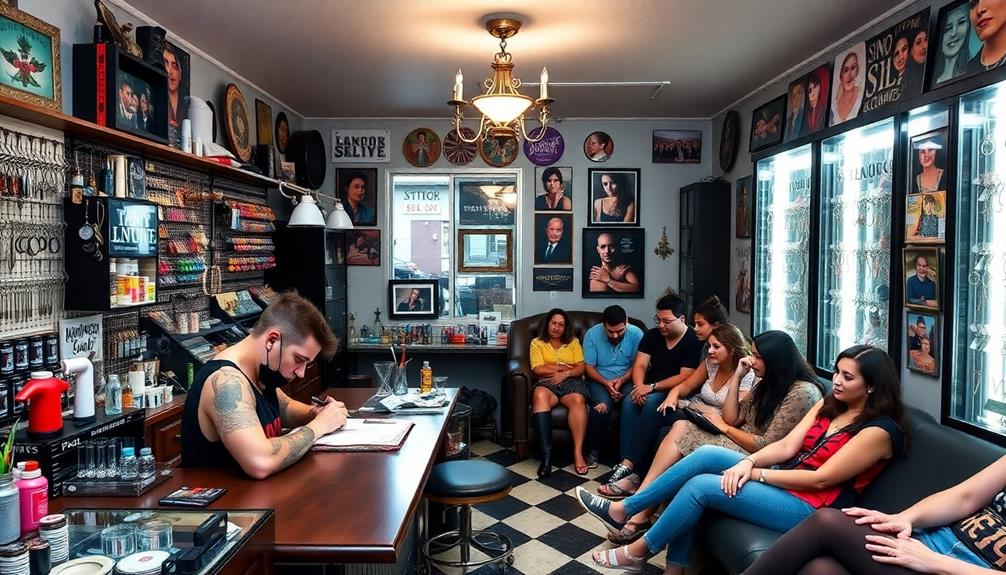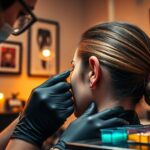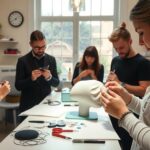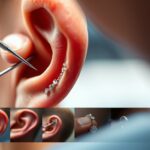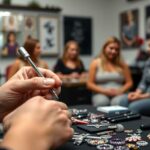As a professional body piercer, your day starts with a thorough sanitation of your workspace and organizing jewelry. You'll create a welcoming environment, putting clients at ease and building trust through open communication. Each piercing is an art form, requiring both technical skill and an understanding of anatomy. Aftercare education is an essential part of the process, ensuring clients heal well. Throughout the day, you engage on social media, sharing your experiences and building a community. Every appointment is not just about the piercing; it's about the impact on your clients. There's so much more to explore.
Key Takeaways
- Morning rituals include workspace sanitation, organizing jewelry, and mental preparation to create a focused and welcoming environment for clients.
- Building trust through effective communication, active listening, and empathy is essential for easing client nerves and ensuring comfort.
- Rigorous safety practices, including sterilization and health assessments, prioritize client well-being before, during, and after the piercing process.
- Mastery of various techniques and understanding anatomy are crucial for performing safe piercings and ensuring proper healing for clients.
- Engagement on social media and community involvement fosters connections, empowering clients while showcasing professional expertise and aftercare education.
Morning Setup Rituals
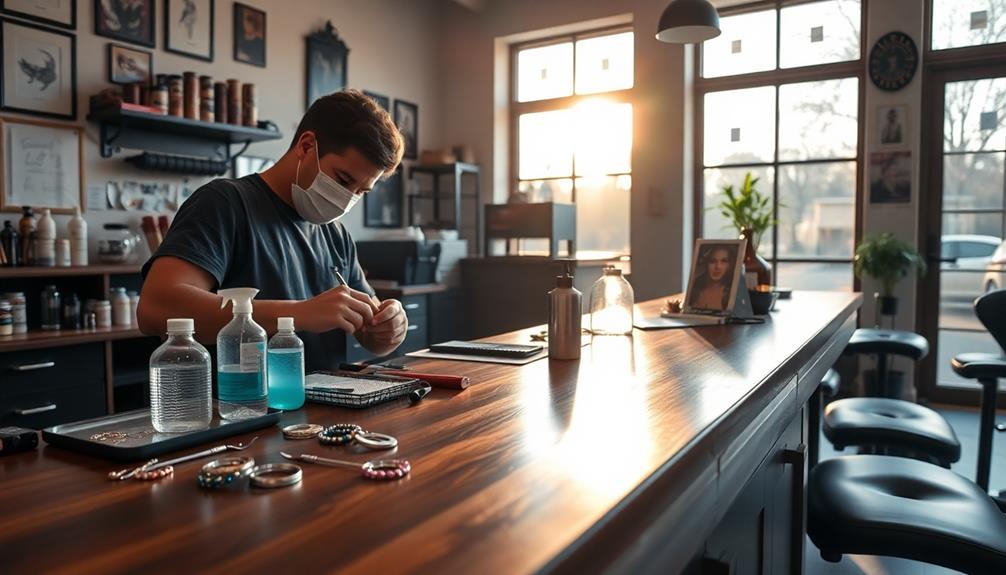
Every morning, a body piercer begins their day with a setup ritual that's fundamental for a successful appointment. You start by thoroughly sanitizing your workspace, ensuring all surfaces and tools are clean and sterile. This step is essential to uphold safety standards and protect your clients.
Next, you organize your body jewelry selection, checking for quality and readiness to provide high-quality options that meet industry standards. As you review your schedule, you mentally prepare for the day ahead. Familiarizing yourself with any special requests or unique client needs helps you tailor your approach.
This preparation also includes acknowledging the emotional aspects of your work, as many clients may arrive feeling nervous about their upcoming piercings. To center yourself, you might engage in a brief ritual, like deep breathing or a moment of reflection. This practice allows you to be present and supportive for your clients.
Client Interactions and Consultations

When you meet a client for their consultation, it's all about building trust and understanding their unique needs.
Establishing a supportive environment is key, as many clients may feel nervous about the piercing process.
You'll use effective communication techniques to guarantee they feel comfortable and heard, addressing any concerns they might have.
This foundation not only enhances their experience but also sets the stage for a successful piercing.
For new fathers, having a solid support network can be just as essential during transformative life moments, as highlighted in the importance of support networks for new fathers.
Building Trust With Clients
Building trust with clients starts by creating a welcoming atmosphere that puts them at ease. When you greet your clients with a friendly demeanor, you set the stage for open communication. This is essential, as effective communication helps you address diverse concerns and expectations.
By providing clear information about the piercing process, you not only inform but also reassure your clients, fostering a sense of trust. It's also important to reflect on their overall health, just as maintaining good oral hygiene habits is important for children, ensuring that they feel safe and cared for during the process.
Demonstrating professionalism further enhances this trust. Adhering to safety protocols and showcasing high-quality jewelry signals your commitment to their well-being. Clients feel more confident in your expertise when they see you prioritize their safety.
Additionally, personal interactions play a significant role in building rapport. By actively listening to your clients' stories and motivations behind their piercings, you establish a deeper connection. This genuine attentiveness shows that you value their experiences and choices.
Understanding Client Needs
A body piercer's ability to understand client needs is essential for creating a positive experience. During the consultation, you'll actively listen to the client's desires and concerns regarding their piercing. This not only establishes trust but also builds rapport.
You'll engage in thorough discussions about aftercare, potential risks, and answer any questions that arise, ensuring clients make informed decisions. Recognizing that emotional factors can influence decisions—much like how emotional dysregulation can impact personal relationships—is vital in understanding clients' unique backgrounds.
Tailoring the experience to accommodate diverse client backgrounds and body positivity journeys is key. This consideration enhances satisfaction and comfort. Clear communication about the piercing process, jewelry options, and expected outcomes helps manage client expectations effectively.
It's also important to observe and respect client boundaries, especially when discussing sensitive topics like body image or personal significance tied to their piercings. Creating a safe and supportive environment allows for open dialogue, enabling clients to express their needs fully.
Effective Communication Techniques
Effective communication techniques are essential during client interactions and consultations, guaranteeing that clients feel heard and understood. By practicing active listening, you can fully grasp your clients' needs, concerns, and expectations, which fosters a positive rapport and builds trust. When clients sense that you genuinely care, they're more likely to open up.
It's also important to recognize that individual responses to experiences can vary greatly, much like how children react differently to supporting children through divorce based on their personality and age.
Providing clear explanations about the piercing process, aftercare, and potential risks helps your clients feel informed and empowered. This knowledge not only reduces anxiety but also enhances their overall experience.
Using inclusive language and being sensitive to diverse backgrounds encourages open communication, making clients feel valued and respected.
Demonstrating empathy is essential. Addressing any fears or hesitations can greatly improve their comfort level, leading to a more successful piercing experience.
Encourage clients to ask questions and provide thorough answers to create an interactive environment. This approach guarantees clients leave feeling satisfied and confident in their decisions.
Safety and Sanitation Practices
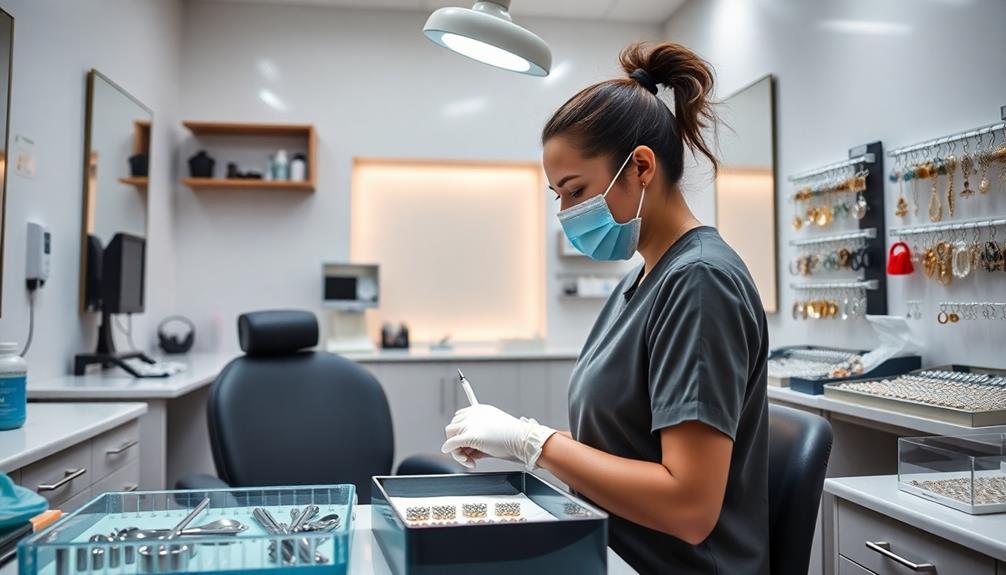
In the world of body piercing, safety and sanitation practices are paramount to ensuring a positive experience for clients. As a professional piercer, you prioritize safety by using only high-quality, biocompatible jewelry, such as titanium and surgical steel. This reduces the risk of allergic reactions and infections, allowing your clients to feel secure in their choice.
Your sanitation practices are rigorous. You thoroughly sterilize all tools and equipment with autoclaves, effectively eliminating any bacteria and viruses before each use. Maintaining a clean workspace is also essential; you regularly disinfect surfaces and use single-use, disposable items whenever possible.
This commitment to hygiene not only protects your clients but also enhances your professional reputation.
Before performing any piercing, you conduct a health assessment of the client. This step helps identify potential contraindications or allergies, ensuring the procedure goes smoothly and safely.
To remain prepared for any emergencies, you engage in ongoing education in first aid and CPR, and you stay updated with local health regulations and industry standards. By adhering to these safety and sanitation practices, you help create a trustworthy environment where clients feel comfortable and cared for.
The Art of Piercing
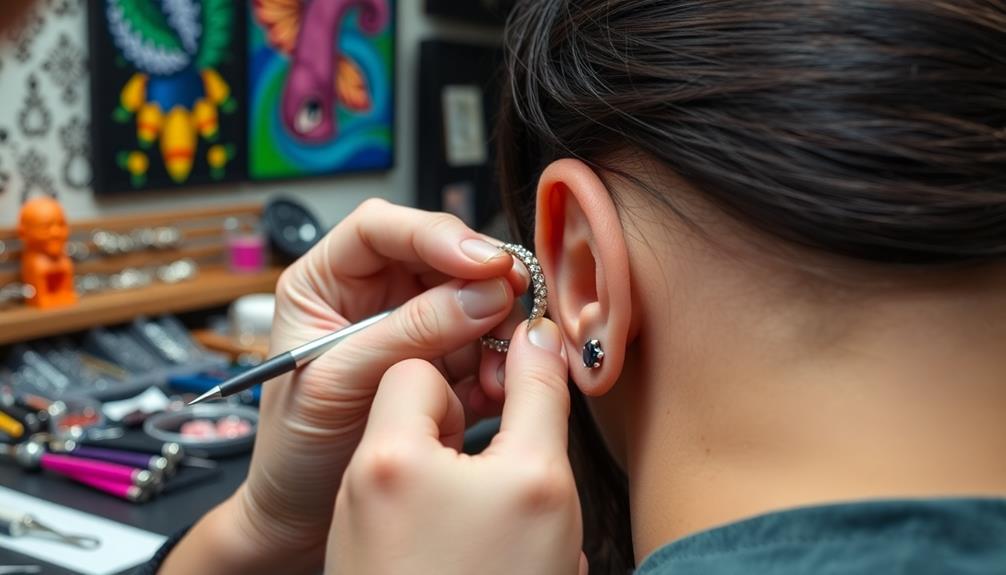
When you step into the world of body piercing, you're not just mastering techniques; you're also embracing the importance of safety and hygiene.
Understanding different styles and how to interact with clients helps you create a comfortable atmosphere while ensuring they receive the best care.
With every piercing, you'll refine your skills and adapt to the unique needs of each individual.
Safety and Hygiene Practices
Maintaining a sterile environment throughout the piercing process is essential for ensuring safety and hygiene. As a professional body piercer, you must adhere to strict protocols to protect both yourself and your clients. Each piercing starts with a thorough sanitation of your work area, followed by the use of single-use, pre-packaged sterile instruments. This minimizes any risk of infection.
Before starting, you assess clients for contraindications or allergies, ensuring the jewelry materials are safe for their skin type. Aftercare is vital; you provide clear instructions to clients about keeping the area clean and avoiding submersion in pools or hot tubs to prevent complications.
Here's a quick overview of key safety and hygiene practices you follow:
| Practice | Description |
|---|---|
| Sterile Gloves | Always wear single-use gloves to prevent contamination. |
| Disinfectants | Use approved disinfectants to clean surfaces and instruments. |
| Sterilization Equipment | Regularly utilize autoclaves for sterilizing tools. |
| First Aid Training | Stay current with first aid and CPR to handle emergencies. |
Techniques and Styles
Body piercing is both an art and a science, blending creativity with technical skill. As you explore this world, you'll discover a variety of techniques that cater to different styles. From traditional needle piercing to modern dermal anchors, each method allows for unique jewelry placements that express individuality.
Consider the emotions behind each piercing:
- The thrill of your first cartilage piercing
- The bold statement of a septum ring
- The elegance of a surface piercing
- The connection to your identity through body art
- The healing journey that follows
Choosing the right jewelry material is vital. Options like titanium, surgical steel, or biocompatible plastics minimize allergic reactions and promote healing.
Understanding the anatomy of your clients is important, too, as it helps prevent nerve damage and guarantees the piercing heals properly.
Aftercare techniques can't be overlooked. You'll educate clients on cleaning and avoiding irritants to prevent infections.
Client Interaction Dynamics
How do you create a welcoming environment for your clients as a body piercer? It starts with effective communication. You need to recognize that each client has unique comfort levels and emotional significance tied to their desire for a piercing.
Incorporating elements of nighttime meditation can also help in calming nerves, making the client feel more at ease. Whether you're working with children, seniors, or those new to body modifications, your aim is to foster trust through active listening and empathy.
By engaging in client interactions that prioritize their feelings and expectations, you not only make them feel at ease but also enhance their overall experience. It's crucial to maintain professional boundaries, especially considering the gender dynamics that might influence a client's comfort in sharing their needs.
Once the piercing process is complete, you should provide clear aftercare instructions. This not only alleviates anxiety but also reinforces your professionalism.
When clients leave with confidence in their aftercare, they're more likely to return and refer others to your services. Remember, a positive experience transcends the physical act of piercing; it's about creating a memorable journey for your clients that respects their individuality and fosters lasting connections.
Aftercare Education

After getting a new piercing, it's crucial to understand that proper aftercare can make all the difference in your healing journey. Following specific aftercare instructions tailored to your piercing type helps guarantee ideal healing and prevents complications.
Regularly clean your piercing with saline solution or a gentle, fragrance-free soap. Remember, your hands shouldn't touch or twist the jewelry during this time; doing so can introduce bacteria and disrupt healing tissue.
Here are some key points to remember for effective aftercare:
- Avoid swimming in pools, hot tubs, or oceans for at least the first few weeks.
- Look out for excessive redness, swelling, or discharge—these could be signs of complications.
- Keep your piercing dry and free from irritants.
- Educate yourself on the best aftercare practices specific to your piercing type.
- Trust your instincts; if something feels off, seek professional help.
With the right education, you can navigate your healing process confidently. Prioritize your aftercare, and you'll enjoy your new piercing for years to come!
Managing Client Emotions
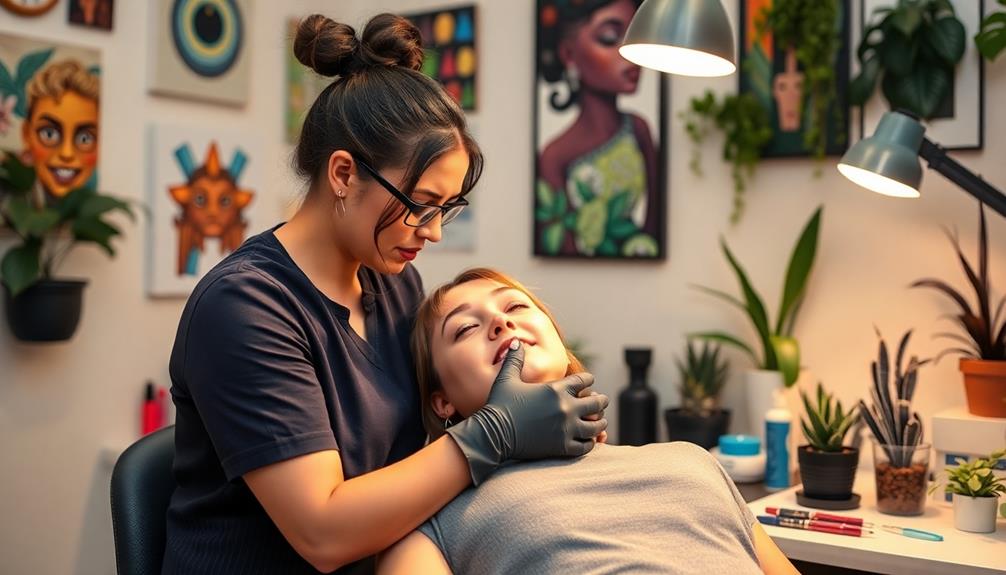
Managing client emotions is an essential part of the piercing process, as many people experience a mix of excitement and anxiety.
You'll often find that about 70% of your clients report feeling nervous before their appointment. To help ease their minds, creating a calming atmosphere is vital. Effective communication plays a key role here; engage in active listening to address their concerns and reassure them.
You might also use humor and share relatable personal stories to foster a connection, helping to lighten the mood. This approach not only eases tension but also makes the experience more enjoyable for them.
It's important to check in with clients after their piercings, too. A simple follow-up message shows you care and strengthens your relationship, increasing their satisfaction and loyalty.
Social Media Engagement

In today's digital age, you can build community connections and showcase your piercing techniques through social media platforms.
By sharing your experiences and expertise, you not only engage with potential clients but also create a supportive network of fellow piercers.
With the right content and hashtags, your posts can reach a wider audience and foster meaningful interactions.
Building Community Connections
Social media has become an essential tool for body piercers looking to build community connections and engage with clients. By leveraging platforms like TikTok, you can showcase your skills while reaching a broader audience. Viral videos, like a corset piercing that hit 1.8 million views, highlight the potential for visibility and connection.
Utilizing data-driven insights can also help you understand your audience better and tailor your content accordingly.
To truly engage your audience, consider these strategies:
- Share educational content about aftercare to empower your clients.
- Use trending hashtags like #piercing and #bodypiercer to increase your reach.
- Post behind-the-scenes glimpses of your daily routine to humanize your brand.
- Participate in social media challenges to connect with others in the industry.
- Respond to comments and messages to foster loyalty among your followers.
Consistent content creation not only attracts aspiring piercers seeking guidance but also strengthens your ties within the community.
As you build relationships through social media, you'll find that your engagement leads to repeat business and a loyal clientele. By embracing these opportunities, you'll become a respected figure in the piercing community, making a lasting impact on those who share your passion for body art.
Showcasing Piercing Techniques
Showcasing your piercing techniques on platforms like TikTok can be a game changer for your visibility and client engagement. Your videos can reach thousands, just like that corset piercing video that hit 1.8 million views! By demonstrating various piercing styles and sharing aftercare tips, you not only highlight your skills as a professional piercer but also educate potential clients about the body piercing process.
This engagement can also mirror the significance of establishing trust and boundaries in relationships, where transparency and communication play a crucial role in fostering connections recognizing signs of stagnation.
Utilizing trending hashtags like #piercing and #bodypiercing enhances your content's reach, connecting you with a community of enthusiasts. This connection is essential for building your client base and reputation.
Educational videos that emphasize safety and professionalism reinforce your commitment to client care and industry standards. Additionally, sharing behind-the-scenes content, such as your preparation and sanitation practices, fosters transparency and builds trust.
Viewers appreciate knowing that their safety is your top priority. By engaging your audience with informative, visually appealing content, you establish yourself as an expert in body piercing. Embracing social media not only showcases your artistry but also creates a dialogue with clients, making them feel more comfortable and informed about their piercing journey.
Challenges of the Day
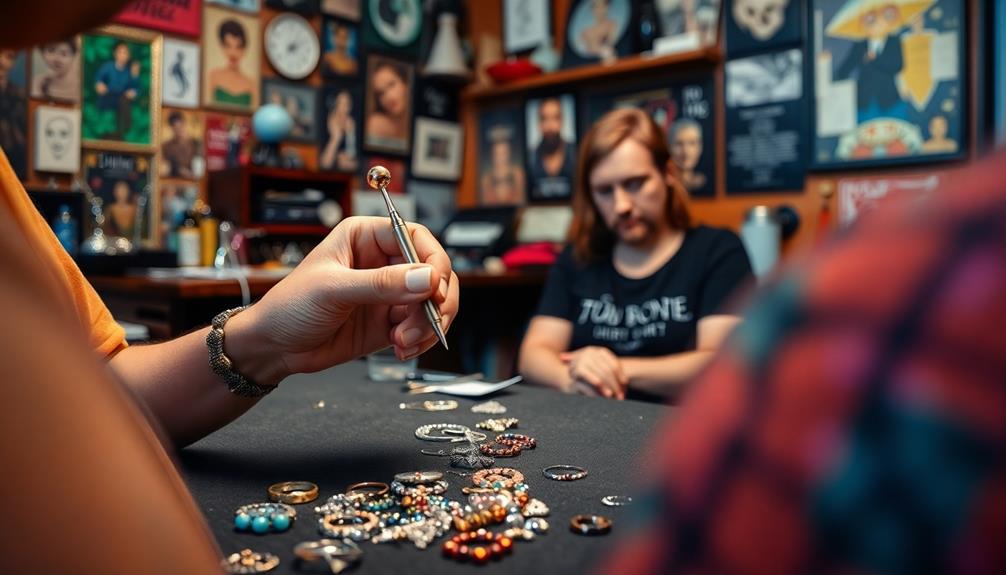
Steering through the daily challenges of a body piercer requires quick thinking and adaptability. You're often faced with managing client expectations, especially when their desires clash with safety or anatomical realities.
It's vital to communicate effectively while providing a safe and enjoyable experience. Understanding the emotional aspects of client interactions is significant, as many clients may have underlying insecurities or fears, similar to those in narcissistic relationships.
On slow days, you feel the pressure to create engaging creative content for social media. It's easy to forget to film each procedure, leading to missed opportunities to showcase your work. The challenge intensifies when you must address clients' concerns about body rejection, educating them on aftercare and potential complications.
You also navigate a variety of unexpected situations, which can range from humorous mishaps to sudden changes in client requests. These moments can disrupt the flow of the day, but your ability to maintain a positive atmosphere is significant.
- Balancing safety with artistic vision
- Educating clients about aftercare
- Capturing the perfect content
- Responding to unexpected client requests
- Laughing through the chaos
Every challenge you face adds to the unique tapestry of your day, making each moment in the studio memorable and rewarding.
Reflections on the Experience

Throughout your day as a body piercer, you often find yourself reflecting on the profound impact you have on your clients' lives. Each appointment isn't just a procedure; it's a chance to create transformative moments. Whether it's the thrill of a first piercing or a commemorative piece for a significant life event, you witness personal stories unfold right before you.
Your commitment to client comfort is always at the forefront. You navigate a fast-paced environment while guaranteeing each client feels safe and valued. The interactions you have provide unique insights into diverse cultural backgrounds, enriching your perspective as you engage with each individual.
To maintain a strong online presence, you document procedures, showcasing your work and connecting with clients. This not only builds your brand but also fosters a community around shared experiences.
| Aspect | Importance | Example |
|---|---|---|
| Client Comfort | Enhances Experience | Calming atmosphere |
| Transformative Moments | Creates Connection | Milestone celebrations |
| Personal Stories | Builds Relationships | Shared backgrounds |
| Safety Protocols | Guarantees Trust | Sanitizing instruments |
| Online Presence | Engages Clients | Social media posts |
Building Community Connections

Every appointment you complete not only transforms your clients but also strengthens the connections within your community. Each interaction is an opportunity to foster relationships that extend beyond the studio.
Engaging with clients on social media using hashtags like #piercing and #bodypiercing allows you to build a vibrant community. By sharing insights on topics such as effective communication in relationships, you further enhance your role as a trusted professional in your field.
Participating in local events and collaborating with other artists enhances visibility and creates lasting bonds. Sharing educational content about aftercare and piercing techniques establishes your professionalism and builds trust.
Documenting your daily routines and client experiences through videos resonates with your audience, making them feel part of the journey.
- You inspire confidence in your clients, encouraging them to express their individuality.
- Each piercing tells a unique story that connects you to your clients.
- You create a safe space where everyone feels welcome and valued.
- Your passion for the craft ignites enthusiasm in others.
- You cultivate a network of support among fellow artists and clients.
Frequently Asked Questions
What's It Like to Be a Body Piercer?
Being a body piercer's exciting and challenging. You meet diverse clients, perform intricate piercings, and guarantee safety. It requires continuous learning, excellent communication skills, and creativity, all while steering through client expectations and maintaining personal boundaries.
Where Do Body Piercers Make the Most Money?
You'd think body piercers make the most money in quiet towns, but it's actually in bustling urban areas. There, high demand, chic studios, and specialty services let you command premium prices and substantial commissions.
How Much Do You Tip a Professional Piercer?
When you tip a professional piercer, aim for 15% to 25% of the total service cost. If they provide exceptional service, consider tipping more. Always check for any "no tipping" policies beforehand.
How Many Piercings Will a Piercer Do at Once?
When you're in the chair, a piercer's hands dance like a skilled musician. They can usually handle 3 to 10 piercings in a day, but it depends on your style, pain tolerance, and their focus on safety.
Conclusion
As the day winds down, you realize that each piercing isn't just a puncture; it's a thread woven into a tapestry of self-expression and identity. You've not only adorned bodies but also connected souls, forging bonds that stretch beyond the studio walls. With every client, you've danced through challenges and triumphs, crafting a community that sparkles like freshly polished jewelry. In this vibrant world, you're not just a body piercer; you're a storyteller, etching tales of courage and beauty.
Hi, my name is Danielle, and I’m an author for piercings-body.com. I have a passion for writing and love to share my knowledge on all things body piercing-related. I’m also a huge advocate for safe body modification practices and believe everyone should be able to make informed decisions about their bodies. When I’m not writing or blogging, I enjoy spending time with my family and friends, practicing yoga, and exploring new places.

